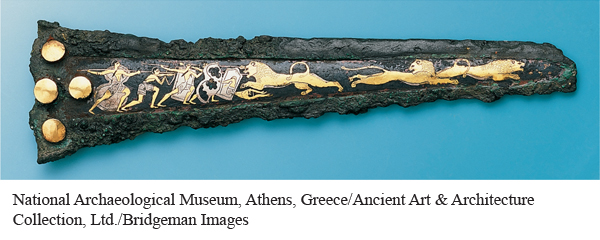A History of Western Society: Printed Page 64
A History of Western Society, Value Edition: Printed Page 59
A History of Western Society, Concise Edition: Printed Page 64
The Mycenaeans
As Minoan culture was flourishing on Crete, a different type of society developed on the mainland. This society was founded by groups who had migrated there during the period after 2000 B.C.E., and its members spoke an early form of Greek. By about 1650 B.C.E. one group of these immigrants had raised palaces and established cities at Thebes, Athens, Mycenae (migh-
As in Crete, the political unit in Mycenaean Greece was the kingdom, and the king and his warrior aristocracy stood at the top of society. The seat and symbol of the king’s power was his palace, which was also the economic center of the kingdom. Within the palace’s walls, royal artisans fashioned gold jewelry and rich ornaments, made and decorated fine pottery, forged weapons, prepared hides and wool for clothing, and manufactured the other goods needed by the king and his supporters. The Mycenaean economy was marked by an extensive division of labor, and at the bottom of the social scale were male and female slaves.
Palace scribes kept records with a script known as Linear B, which scholars realized was an early form of Greek and have learned to read. They thus consider the Mycenaeans the first truly “Greek” culture to emerge in this area. Information on Mycenaean culture comes through inscriptions and other forms of written records as well as buildings and other objects. All of these point to a society in which war was common. Mycenaean cities were all fortified by thick stone walls, and graves contain bronze spears, javelins, swords, helmets, and the first examples of metal armor known in the world. Mycenaean kingdoms appear to have fought regularly with one another.
Contacts between the Minoans and Mycenaeans were originally peaceful, and Minoan culture and trade goods flooded the Greek mainland. But most scholars think that around 1450 B.C.E., possibly in the wake of an earthquake that left Crete vulnerable, the Mycenaeans attacked Crete, destroying many towns and occupying Knossos. For about the next fifty years, the Mycenaeans ruled much of the island. The palaces at Knossos and other cities of the Aegean became grander as wealth gained through trade and tribute flowed into the treasuries of various Mycenaean kings. Linear B replaced Linear A as a writing system, a further sign of Mycenaean domination.

Prosperity, however, did not bring peace, and between 1300 and 1100 B.C.E. various kingdoms in and beyond Greece ravaged one another in a savage series of wars that destroyed both the Minoan and Mycenaean civilizations. Among these wars was perhaps one that later became known as the Trojan War, fought by Greeks in Ionia (see “Homer, Hesiod, and the Epic”).
The fall of the Minoans and Mycenaeans was part of what scholars see as a general collapse of Bronze Age civilizations in the eastern Mediterranean, including the end of the Egyptian New Kingdom and the fall of the Hittite Empire (see Chapters 1 and 2). This collapse appears to have had a number of causes: internal economic and social problems, including perhaps slave revolts; invasions and migrations by outsiders, who destroyed cities and disrupted trade and production; changes in warfare and weaponry, particularly the adoption of iron weapons, which made foot soldiers the most important factor in battles and reduced the power of kings and wealthy nobles fighting from chariots; and natural disasters such as volcanic eruptions, earthquakes, and droughts, which reduced the amount of food and contributed to famines. Mycenaean Greeks joined the migrating Sea Peoples and probably settled in Canaan; here they became the group known in the Bible as Philistines (see Chapter 2).
These factors worked together to usher in a period of poverty and disruption that historians of Greece have traditionally called the Dark Age (ca. 1100–800 B.C.E.). Cities were destroyed, population declined, villages were abandoned, and trade decreased. Migratory movements continued, including a group that later Greeks called the Dorians, who were originally thought to have been people speaking a language other than Greek invading from the north. Now the Dorians are generally regarded as Greek-
The Bronze Age Collapse led to the widespread and prolonged movement of Greek peoples, both within Greece itself and beyond. They dispersed beyond mainland Greece farther south to the islands of the Aegean and in greater strength across the Aegean to the shores of Anatolia, arriving at a time when traditional states and empires had collapsed. By the conclusion of the Dark Age, the Greeks had spread their culture throughout the Aegean basin, and like many other cultures around the Mediterranean and the Near East, they had adopted iron.